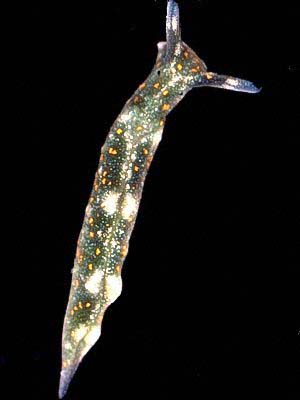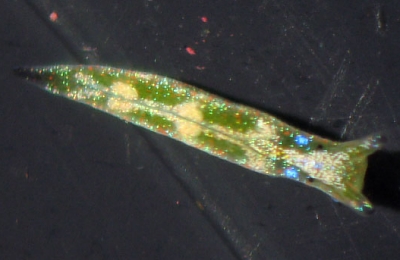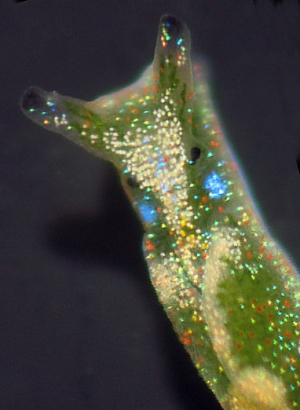
Elysia cf. furvacauda
Order: SACOGLOSSA
Superfamily: ELYSIOIDEA
Family: Elysiidae
DISTRIBUTION
Recorded in New South Wales, eastern Australia.
PHOTO
Quibray Bay, Botany Bay, Sydney, New South Wales, Australia, May 1980. (from material studied by Brian Brandley).
PHOTO: Bill Rudman.
RELATED TOPIC
This sacoglossan was the subject of an extremely interesting study by Brian Brandley (University of Sydney). He showed that this species obtains plastids from the algae it feeds on, and keeps them alive in its body, where they continue to photosynthesise and provide sugars for the slug. Of even greater interest was his discovery that the slug changed diet at least three times during its annual life history and was able to use the plastids from each of the algae it fed on.
Reference:
• Brandley, B., 1984. Aspects of the ecology and physiology of Elysia cf. furvacauda (Mollusca: Sacoglossa). Bulletin of Marine Science, 34: 201-219.
This species has similarities to Elysia furvacauda Burn, 1958, from Victoria in south-eastern Australia, but is considered distinct until a fuller comparison can be made.
Authorship detailsRudman, W.B., 1999 (February 19) Elysia cf. furvacauda [In] Sea Slug Forum. Australian Museum, Sydney. Available from http://www.seaslugforum.net/find/elyscffurv
Related messages
Elysia cf. furvacauda from sthn Queensland
July 15, 2008
From: Gary Cobb


Hi Bill and everyone!
Here are some photos of Elysia cf. furvacauda we found on rocks from Alexandra Headland and Woody point. The animals a small when photos are taken on black they come alive with vivid colour.
Locality: Sunshine Coast near Mooloolaba, 50 mm, Queensland, Australia, Pacific Ocean, 01 July 2008, Intertidal. Length: 2 mm. Photographer: Gary Cobb and David Mullins.
Cheers
Gary Cobb
gary@nudibranch.com.au
Cobb, G.C., 2008 (Jul 15) Elysia cf. furvacauda from sthn Queensland. [Message in] Sea Slug Forum. Australian Museum, Sydney. Available from http://www.seaslugforum.net/find/21669
Thanks Gary,
The spectacular colours in this species remind me of cheap, but very flashy, jewellery - what might be called a severe case of bling!
Best wishes,
Bill Rudman
Re: Elysia cf. furvacauda page
April 8, 2000
From: Cynthia Trowbridge
Dear Bill,
I was wondering if you might be able to clarify an issue for me. I have read Brian Brandley's intriguing papers about the feeding ecology and physiology of the Australian Elysia cf. furvacauda. But in looking for dietary information for E. furvacauda, I can find no details. Burn (1998) in the Mollusca, the Southern Synthesis mentioned that the species was common in seagrass beds. I was specifically wondering whether it might eat Codium spp. Any information or thoughts would be much appreciated. Thank you for your assistance!
Cordially,
Cynthia D. Trowbridge
Oregon State University
trowbric@ucs.orst.edu
Trowbridge, C., 2000 (Apr 8) Re: Elysia cf. furvacauda page. [Message in] Sea Slug Forum. Australian Museum, Sydney. Available from http://www.seaslugforum.net/find/2231Note added 14 July 2006: See message #17114 for photo of real Elysia furvacauda.
Dear Cynthia,
I'm afraid I can't help. I know of only two references to true Elysia furvacauda from Victoria and in them Bob Burn described the animal as rare. 'dull pinkish brown colour with small blue patches'.
I don't even think there is a photo of it anywhere. I suspect the animal Brian Brandley worked on is not this species and that is why I suggested he refer to it as Elysia cf. furvacauda.
For those not familiar with Brian Brandley's paper, which is cited above, Elysia cf. furvacauda changes its diet seasonally. In Australian autumn-winter (March-July) it prefers living on the brown algae Sargassum feeding on epiphytic red algae and taking up red plastids (rhodoplasts) from the algae. In Spring (August-September) there is a transition to Codium and a change to chloroplasts (and a green colour) and by Summer a large proportion of the population were found on Codium. During the transition period animals did not photosynthesise but after a 'settling in' period the plastids become fully functional.
Cynthia, If I hear anything about 'true' E. furvacauda I will let you know.
Best wishes,
Bill Rudman.
Elysia cf. furvacauda page
February 19, 1999
From: Brian Brandley
Hi Bill,
I was taking advantage of the internet to reminisce about my previous scientific life, and found your page on Elysia furvacauda. It's been a long time, and I now work for a biotech company, but I was very happy to see the extent of the opisthobranch information and photos that you have made available for us all. And it's nice to see that some old friends are still doing what they love. I'm having fun in the biotech world, but if I was independently wealthy I would still be studying opisthobranchs. Unfortunately, the best I can do is poke around on vacation. When my wife and I were in Hawaii on holiday, I managed to find several hundred Plakobranchus at one location - we were both impressed that I could still find the critters.
Anyway, hope you are happy and well.
Regards
Brian Brandley
brandley@glyko.com
Brandley, B., 1999 (Feb 19) Elysia cf. furvacauda page. [Message in] Sea Slug Forum. Australian Museum, Sydney. Available from http://www.seaslugforum.net/find/590Dear Brian,
Great to hear from you. I wondered what had become of you when I was writing the page. I'm sorry you aren't still working with opisthobranchs but glad to see that Plakobranchus still can't escape your eagle eye!
Bill Rudman
